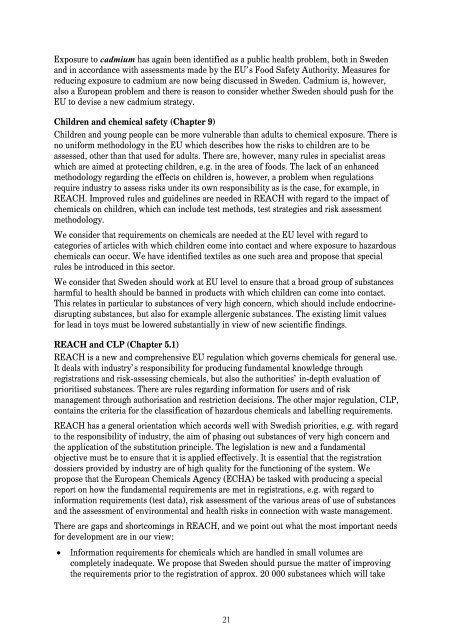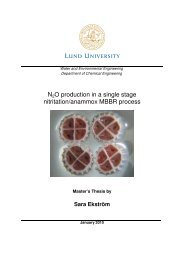Bättre EU-regler för en giftfri miljö - Kemikalieinspektionen
Bättre EU-regler för en giftfri miljö - Kemikalieinspektionen
Bättre EU-regler för en giftfri miljö - Kemikalieinspektionen
Create successful ePaper yourself
Turn your PDF publications into a flip-book with our unique Google optimized e-Paper software.
Exposure to cadmium has again be<strong>en</strong> id<strong>en</strong>tified as a public health problem, both in Swed<strong>en</strong><br />
and in accordance with assessm<strong>en</strong>ts made by the <strong>EU</strong>’s Food Safety Authority. Measures for<br />
reducing exposure to cadmium are now being discussed in Swed<strong>en</strong>. Cadmium is, however,<br />
also a European problem and there is reason to consider whether Swed<strong>en</strong> should push for the<br />
<strong>EU</strong> to devise a new cadmium strategy.<br />
Childr<strong>en</strong> and chemical safety (Chapter 9)<br />
Childr<strong>en</strong> and young people can be more vulnerable than adults to chemical exposure. There is<br />
no uniform methodology in the <strong>EU</strong> which describes how the risks to childr<strong>en</strong> are to be<br />
assessed, other than that used for adults. There are, however, many rules in specialist areas<br />
which are aimed at protecting childr<strong>en</strong>, e.g. in the area of foods. The lack of an <strong>en</strong>hanced<br />
methodology regarding the effects on childr<strong>en</strong> is, however, a problem wh<strong>en</strong> regulations<br />
require industry to assess risks under its own responsibility as is the case, for example, in<br />
REACH. Improved rules and guidelines are needed in REACH with regard to the impact of<br />
chemicals on childr<strong>en</strong>, which can include test methods, test strategies and risk assessm<strong>en</strong>t<br />
methodology.<br />
We consider that requirem<strong>en</strong>ts on chemicals are needed at the <strong>EU</strong> level with regard to<br />
categories of articles with which childr<strong>en</strong> come into contact and where exposure to hazardous<br />
chemicals can occur. We have id<strong>en</strong>tified textiles as one such area and propose that special<br />
rules be introduced in this sector.<br />
We consider that Swed<strong>en</strong> should work at <strong>EU</strong> level to <strong>en</strong>sure that a broad group of substances<br />
harmful to health should be banned in products with which childr<strong>en</strong> can come into contact.<br />
This relates in particular to substances of very high concern, which should include <strong>en</strong>docrinedisrupting<br />
substances, but also for example allerg<strong>en</strong>ic substances. The existing limit values<br />
for lead in toys must be lowered substantially in view of new sci<strong>en</strong>tific findings.<br />
REACH and CLP (Chapter 5.1)<br />
REACH is a new and compreh<strong>en</strong>sive <strong>EU</strong> regulation which governs chemicals for g<strong>en</strong>eral use.<br />
It deals with industry’s responsibility for producing fundam<strong>en</strong>tal knowledge through<br />
registrations and risk-assessing chemicals, but also the authorities’ in-depth evaluation of<br />
prioritised substances. There are rules regarding information for users and of risk<br />
managem<strong>en</strong>t through authorisation and restriction decisions. The other major regulation, CLP,<br />
contains the criteria for the classification of hazardous chemicals and labelling requirem<strong>en</strong>ts.<br />
REACH has a g<strong>en</strong>eral ori<strong>en</strong>tation which accords well with Swedish priorities, e.g. with regard<br />
to the responsibility of industry, the aim of phasing out substances of very high concern and<br />
the application of the substitution principle. The legislation is new and a fundam<strong>en</strong>tal<br />
objective must be to <strong>en</strong>sure that it is applied effectively. It is ess<strong>en</strong>tial that the registration<br />
dossiers provided by industry are of high quality for the functioning of the system. We<br />
propose that the European Chemicals Ag<strong>en</strong>cy (ECHA) be tasked with producing a special<br />
report on how the fundam<strong>en</strong>tal requirem<strong>en</strong>ts are met in registrations, e.g. with regard to<br />
information requirem<strong>en</strong>ts (test data), risk assessm<strong>en</strong>t of the various areas of use of substances<br />
and the assessm<strong>en</strong>t of <strong>en</strong>vironm<strong>en</strong>tal and health risks in connection with waste managem<strong>en</strong>t.<br />
There are gaps and shortcomings in REACH, and we point out what the most important needs<br />
for developm<strong>en</strong>t are in our view:<br />
• Information requirem<strong>en</strong>ts for chemicals which are handled in small volumes are<br />
completely inadequate. We propose that Swed<strong>en</strong> should pursue the matter of improving<br />
the requirem<strong>en</strong>ts prior to the registration of approx. 20 000 substances which will take<br />
21















